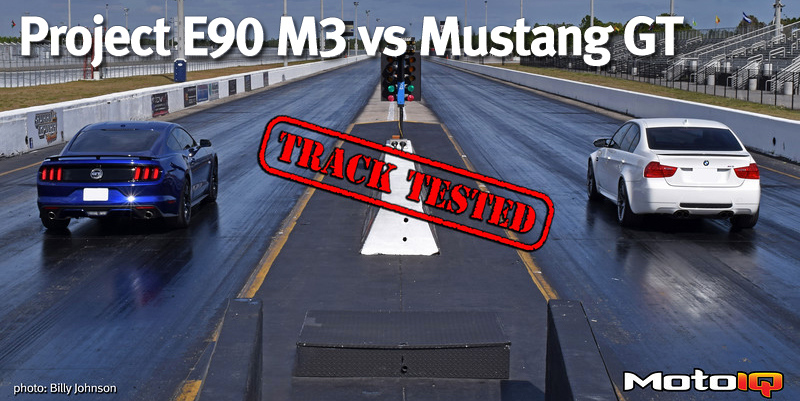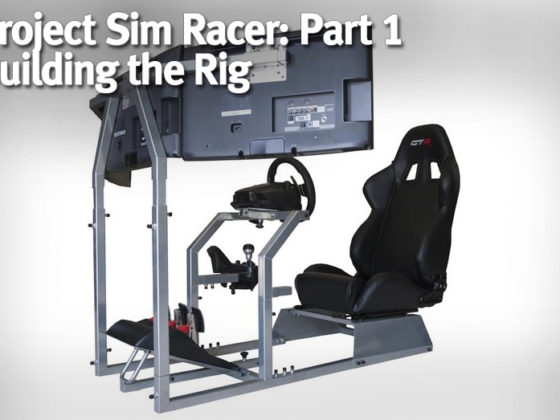Packing more than 50whp over stock, our Project E90 M3 took to the track at Palm Beach International Raceway (ROAD COURSE) to see how it stacks up against a 2016 Ford Mustang GT. Both cars have similar power, weight, and are equipped with similarly sized Continental ExtremeContact DW tires. How will our modified 8 year old sport sedan benchmark compare to a modern “pony car” that’s transitioned away from its roots to become a corner carver? Read on to find out.
If you’re familiar with Project E90 M3, then you’ve read about the modifications we’ve done to bump the power output from the factory rated 414bhp (which produced a lackluster 337whp) to over 465bhp (>380whp) through an ECU tune, test pipes, and K&N air filters. But as time marches on, so does development and progress. Especially for the Blue Oval brand who over the last 10 years has stepped up their game significantly.

Ford actually benchmarked the E92 M3 for their highest track-capable variant of the S197 chassis, the Boss 302 Mustang. It’s arguably the best handling car with a solid axle to ever roll of a dealership lot. As the class leader for over 30 years, the M3 deserves to be a benchmark due to its world-class handling, motorsport heritage, superb handling and pure driving experience. While you can argue over the direction that BMW’s M division has taken their products over each generation, as car guys it’s hard to dislike any M3. For the Ford brand to make a car turn a faster lap time than an M3 is a big statement. Having raced both an E92 M3 and BOSS 302R in the IMSA Continental Tire Series -against each other over the years, I have an appreciation for both makes and they are both very capable machines.
Fast forward to 2015 and the introduction of the S550 Mustang with a (good) independent rear suspension. The S550 was a significant departure away from the solid axle layout that the Mustang had for 50 years, and they took some notes from the BMW handbook with the use of dual ball joint front lower control arms, which are used on the E9X M3, and an integral link independent rear suspension whose design has been used on BMW 5 and 7 series since the 90’s. You can read more about the car in my Review of the 2015 Mustang GT.

With the greatly increased performance of the IRS rear suspension and a more refined chassis, Ford touted their base Mustang GT with the optional Performance Package as outperforming a BOSS 302 on track, and thus outperforming an E92 M3. While there is something to be said for comparing cars as they are fresh off the showroom floor, especially when performance cars these days are often developed with bespoke tires, there will always be disputes over what tire or what chassis is better. No excuses can be made when you compare two cars with the same tire.
But Project E90 M3 isn’t the carbon-fiber roofed M3 benchmark that Ford used. With an additional 2 doors, a cold weather and electronics package with navigation, a steel roof and a heavy sunroof, our M3 isn’t the most pure track variant and is optioned out as one of the heaviest. On the flip side, our challenging 2016 Mustang GT isn’t a Performance Package, but rather a California Special with the large Sync 3 infotainment system. What’s “special” about this California Special? Well, not much in terms of performance. The CS package includes Alcantara seats and a lot of cosmetic differences from black stripes on the hood and side to blacked out hood vents, rear wing, and bespoke rear deck lid panel with a faux throwback gas cap.

When it comes to performance, the California Special isn’t any different than a base Mustang GT, from the standard 4 piston calipers and 13.9” rotors to the 3.31 final drive and weak “Traction-Lok” limited slip differential, the CS does not have the larger 6-piston calipers with 15” rotors, larger radiator, stiffer front springs, swaybar, dampers, K-brace, and Torsen diff with a 3.73 final drive that comes with the Performance Package. However, this Mustang is equipped with the Performance Package wheels which increase the rear tires width from 255 to 275.
While both the M3 and Mustang are not ‘stripper’ models that are spec’d for ultimate performance, they represent variants that are more common with features people would like to live with on a daily basis. Both cars are also equipped with the same Continental ExtremeContact DW, which is one of our favorite Extreme High Performance tires due to their dry handling, wet grip, hydroplaning resistance, quiet and comfortable ride, and excellent tire life.




1 comment
These cars look simple but modern and good. How much is it?